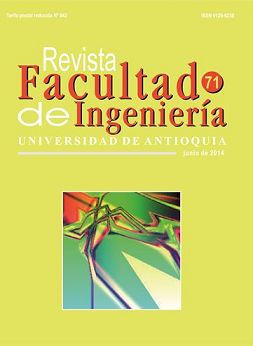Vehicular traffic monitoring in V2I systems using a wireless sensor network
DOI:
https://doi.org/10.17533/udea.redin.15672Keywords:
traffic monitoring, clustering, VANET, WSN, nformation transmission mechanisms, energy consumption, event driven reportingAbstract
In the near future the majority of the automotive systems will strongly rely on the exchange of information among vehicles or infrastructure to improve the driving conditions, increment security or simply have access to internet and entertainment services. This is the reason why the research and development of Vehicular Ad-Hoc Networks is very important nowadays. In this paper, a design and analysis of a Vehicular Ad-Hoc Network (VANET) assisted by an event driven Wireless Sensor Network (WSN) for traffic monitoring in a highway is presented. The aforementioned WSN is based on the well-known LEACH protocol. However, a key modification is proposed in order to increase the network lifetime for applications on VANETs. The basic idea is to minimize the overlapping areas among neighboring clusters in order to reduce redundancy and to have a better coverage of the supervised highway with a lower transmission cost. Additionally, two different methods for the event reporting are proposed. In the first one, the traffic information is transmitted exclusively among the WSN nodes, while the second method makes use of the vehicles in order to relay the information to the sink. The proposed methods are analyzed in terms of energy consumption and average report delay.
Downloads
References
H. Trivedi, P. Veeraraghavan, S. Loke, H. Phuong, J. Singh. A Survey of Lower Layer Technologies for Vehicle-to-Vehicle Communication. Proc. IEEE Malaysia International Conference on Communications. Kuala Lumpur, Malaysia. 2009. pp. 441-446. DOI: https://doi.org/10.1109/MICC.2009.5431547
M. Nekoui, A. Eslami, H. Pishro. The Capacity of Vehicular Ad Hoc Networks with Infrastructure. 6th International Symposium on Modeling and Optimization in Mobile, Ad Hoc. Wireless Networks and Workshops. Berlin, Germany. 2008. pp. 267-272. DOI: https://doi.org/10.4108/ICST.WIOPT2008.3258
I. Akiyldiz, W. Su, Y. Sankarasubramaniam, E. Cayirci. “A Survey on Sensor Networks.” IEEE Commun. Mag. Vol. 40. 2002. pp. 102-114. DOI: https://doi.org/10.1109/MCOM.2002.1024422
K. Kredo, P.Mohapatra. “Medium Access Control in Wireless Sensor Networks.” Comput. Netw. Vol. 51. 2007. pp. 961-994. DOI: https://doi.org/10.1016/j.comnet.2006.06.012
L. Wang, Y. Xiao. “A Survey of Energy-efficient Scheduling Mechanisms in Sensor Networks.” Mobile Netw. Appl. Vol. 11. 2006. pp. 723-740. DOI: https://doi.org/10.1007/s11036-006-7798-5
R. Underwood. Speed, Volume, and Density Relationships: Quality and Theory of Traffic Flow. Pennsylvania State University, University Park, USA. 2004. pp. 141-188.
S. Ardekani, M. Ghandehari, S. Nepal. “Macroscopic Speed-Flow Models for Characterization of Freeway and Managed Lanes.” Institutul Politehnic din Iasi. Buletinul. Sectia Constructii. Arhitectura Vol. 57. 2011. pp. 140-160.
W. Heinzelman, A. Chandrakasan, H. Balakrishnan. “An Applications Specific Protocol Architecture for Wireless Microsensor Networks.” IEEE Transactions on Wireless Communications. Vol. 1. 2002. pp. 660-670 DOI: https://doi.org/10.1109/TWC.2002.804190
Downloads
Published
How to Cite
Issue
Section
License
Copyright (c) 2018 Revista Facultad de Ingeniería

This work is licensed under a Creative Commons Attribution-NonCommercial-ShareAlike 4.0 International License.
Revista Facultad de Ingeniería, Universidad de Antioquia is licensed under the Creative Commons Attribution BY-NC-SA 4.0 license. https://creativecommons.org/licenses/by-nc-sa/4.0/deed.en
You are free to:
Share — copy and redistribute the material in any medium or format
Adapt — remix, transform, and build upon the material
Under the following terms:
Attribution — You must give appropriate credit, provide a link to the license, and indicate if changes were made. You may do so in any reasonable manner, but not in any way that suggests the licensor endorses you or your use.
NonCommercial — You may not use the material for commercial purposes.
ShareAlike — If you remix, transform, or build upon the material, you must distribute your contributions under the same license as the original.
The material published in the journal can be distributed, copied and exhibited by third parties if the respective credits are given to the journal. No commercial benefit can be obtained and derivative works must be under the same license terms as the original work.










 Twitter
Twitter